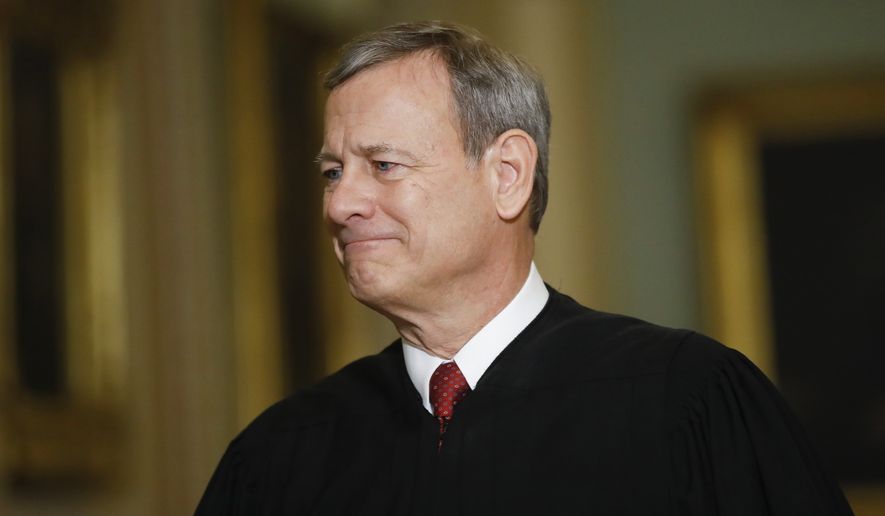As goes Justice Brett M. Kavanaugh, so went the Supreme Court — at least over the recent term.
Flip his vote, and Roe remains precedent, albeit with major new loopholes. Another flip, and President Biden’s catch-and-release policy at the border takes a major hit instead of being bolstered by the high court’s final ruling of its 2021-2022 oral argument calendar. The same goes for a means-of-execution case for death row inmates and Mr. Biden’s vaccine mandate for medical workers.
Justice Kavanaugh and Chief Justice John G. Roberts Jr. emerged as the majority makers for the court, joining the majority decision in all but three of the court’s roughly 60 decisions on argued cases, according to data compiled by Empirical SCOTUS.
The two Republican-appointed justices were also responsible for more than half of the cases in which the court’s liberal bloc emerged as victors in 5-4 rulings, delivering a few key wins to Mr. Biden on executive powers in what was otherwise a brutal term for the political left.
Carl Tobias, a law professor at the University of Richmond, said the Democratic appointees seem to have a chance of persuading the two justices to agree in cases “that involve the court as an institution, and precedent.”
“But that seems less likely on some culture war issues,” he said.
SEE ALSO: Treasury Dept. blocking probe into Hunter Biden’s business dealings, says top GOP lawmaker
The court has six justices appointed by Republican presidents, often referred to as the “conservative” bloc: Chief Justice Roberts, Justice Kavanaugh and Justices Clarence Thomas, Samuel A. Alito Jr., Neil M. Gorsuch and Amy Coney Barrett.
The remaining three members were appointed by Democratic presidents and dubbed the “liberal” wing: Justices Sonia Sotomayor, Elena Kagan and Ketanji Brown Jackson, who replaced Justice Stephen G. Breyer after the term’s final opinions were released last week.
The liberals had a rough go over the past nine months. They were sidelined as the court issued a series of rulings wiping away decades of precedent governing religion, abortion and guns.
Most of those decisions were 6-3, though 11 cases were decided by 5-4 rulings — and the liberal justices did surprisingly well.
The liberal bloc emerged with victories backing Mr. Biden’s plan to end the Trump-era “Remain in Mexico” border policy, upholding the president’s medical worker vaccine mandate, settling a couple of state sovereignty questions and delivering a reading on complicated Medicare reimbursement rates that could control billions of dollars in federal spending.
In each of those cases, the liberal wing found common ground with Republican appointees — most often the chief justice and Justice Kavanaugh.
SEE ALSO: Justices say DHS has power to end Trump’s ‘Remain in Mexico’ border policy
Analysts have been searching for a new center to the court — the key justice on the nine-member court whose vote swings the 5-4 cases one way or another.
Over the course of the past two decades, that role was played by Justice Sandra Day O’Connor and then Justice Anthony M. Kennedy. Some analysts predicted Chief Justice Roberts would fill the role.
Mike Davis, founder of the Article III Project, said it’s “not that simple” to say a new center has emerged.
“I think it depends on the case,” he said.
He pointed to Justice Gorsuch, whom he once served as a law clerk, as another member who found common ground with the liberal wing, particularly on issues of tribal sovereignty and the procedural rights of criminal defendants.
In the four 5-4 rulings in which the liberals were in the minority, Justice Gorsuch was their dance partner in three.
“Justice Gorsuch doesn’t view his job as a political actor, and he’s not concerned about the political consequences of his legal rulings,” Mr. Davis said.
Adam Feldman, creator of Empirical SCOTUS, which tracks the high court’s voting coalitions, said it’s too early to predict whether Justice Kavanaugh or Chief Justice Roberts has become the court’s new center.
“There’s not a sufficient number of cases to really make that claim, at least with certitude,” he said.
Mr. Feldman said he expects the court to produce “some interesting combinations” in future 5-4 rulings but, like the recently concluded term, they won’t be the cases that garner the most attention.
“In the past, those have been the big-ticket items, especially when Kennedy was on the court, those were the bigger cases. Now we don’t see that,” he said.
Mr. Davis said the upshot is that the court is decidedly different from what it was just a few years ago.
“President Trump transformed the 5-4 Roberts Court to the 5-4 Clarence Thomas court, so you’re going to see more consequential decisions during this transition period,” he said. “You’re going to see three justices, Thomas, Alito and Gorsuch, taking a more ‘let the chips fall where they may’ approach, and you’re going to see the chief justice, Kavanaugh and, to a lesser extent, Barrett take a more cautious incremental approach.”
Analysts said the divisive cases get the attention but it’s crucial to also look at the cases that produced unanimity. The justices decided 14 cases by 9-0 rulings and two others by 8-0 decisions. Another 10 rulings were 8-1.
In terms of individual members, Justice Kavanaugh and Chief Justice Roberts were in the majority on 56 out of 59 rulings, according to Mr. Feldman’s Empirical SCOTUS. Justice Alito was next with 49 cases in the majority and 10 in dissent.
On the other end was Justice Sonia Sotomayor, who dissented in 24 of the 59 cases in Mr. Feldman’s count. That meant she was still in the majority about 60% of the time.
• Stephen Dinan can be reached at sdinan@washingtontimes.com.




Please read our comment policy before commenting.